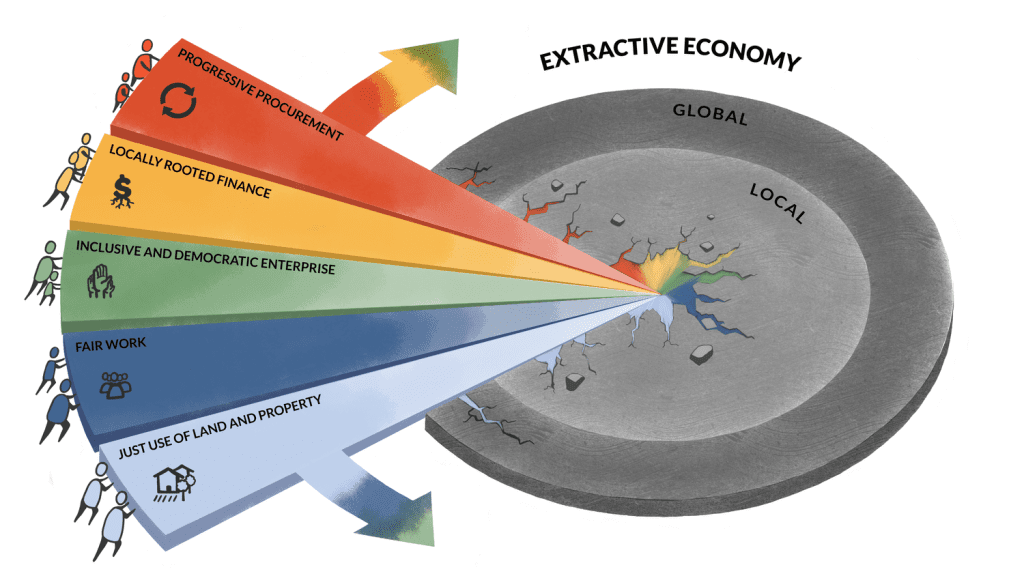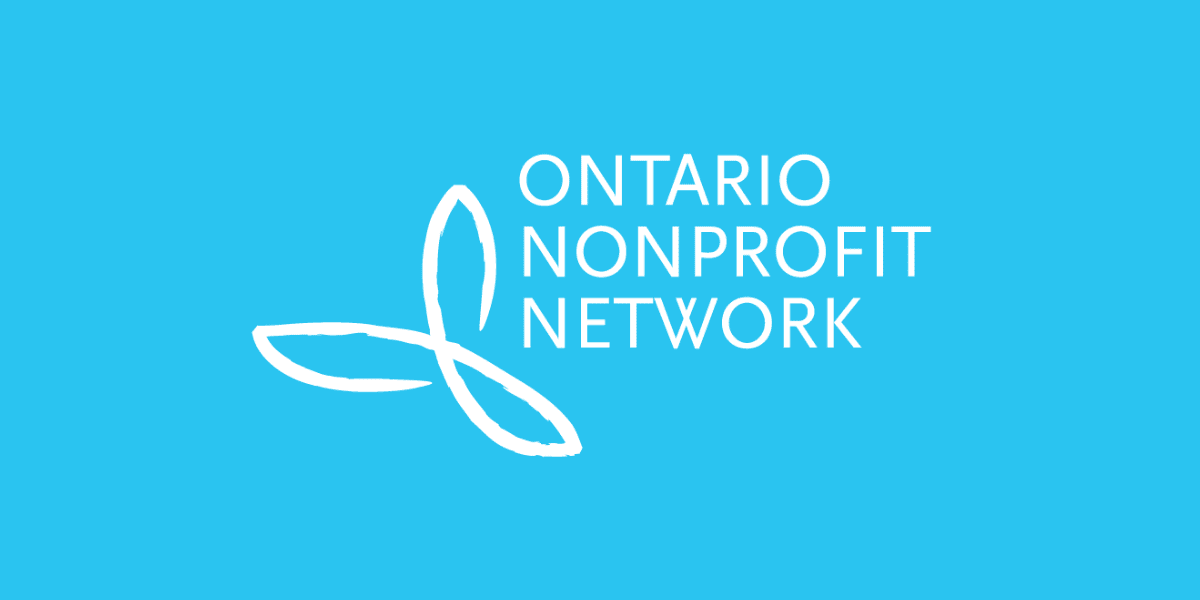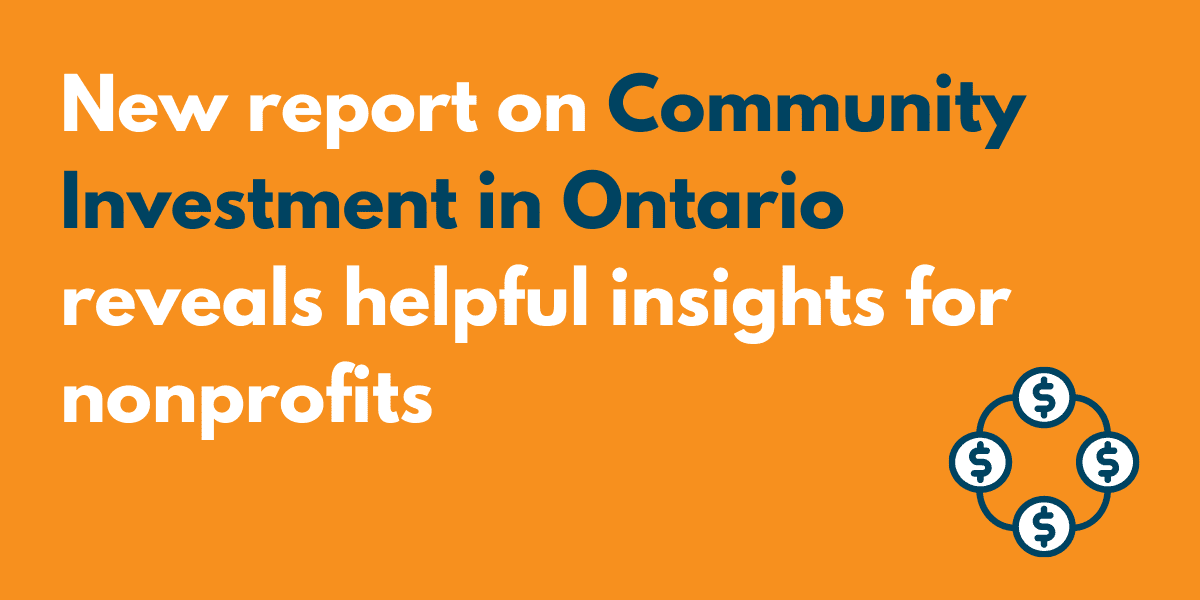
Blog
Community wealth building: A pathway to advancing economic and racial justice
Racial and economic justice are inextricably linked and one cannot be achieved without the other. One of the many consequences of systemic racism and colonization is that Black, Indigenous, and racialized communities hold less economic power as they’ve been denied equal economic opportunities over generations.
The economic development model community wealth building offers nonprofits an opportunity to advance both racial and economic justice by redirecting wealth back into local communities. However, organizations must proceed with an explicit anti-racism and reconciliation approach to ensure that these efforts are reaching targeted communities. Failure to implement intersectional analysis in the development of a new economic system will only reproduce the racial economic inequalities we see in our system today.
Connecting community wealth building to racial and economic justice
When profit motives and property rights are considered more important than people, the giant triplets of racism, economic exploitation, and militarism are incapable of being conquered.
Dr. Martin Luther King Jr.

Community wealth building has a proven track record of putting power and control back into community hands by creating a resilient and inclusive economy for the benefit of the local area. It keeps resources (i.e. jobs, land, wealth) within the community through enterprises that are local, democratic, and inclusive. It delivers for those who have historically been the most excluded and exploited, and has the potential to provide systemic solutions to poverty, housing crises, and routine recessions. When a racial justice lens is applied, community wealth building also has the potential to advance racial equity. To understand the connection between community wealth building and racial justice, it is helpful to understand the connection between structural racism, colonialism, and economic exclusion.
Structural racism has prevented Black, Indigenous, and racialized communities from building generational wealth. The Canadian economy was built on the theft of Indigenous lands and resources, and the extraction of wealth from Black, Indigenous, and racialized communities.
- From 1783 to 1875 Black arrivants came to British North America (Canada) from the U.S. after the British government offered generous land grants to new settlers. It was during this period when systemic differences in land ownership and the ability to create generational wealth took place. Black families received smaller plots of poor-quality land and were denied deeds to the land and instead issued “tickets of location”. This prevented Black settlers from passing down their property and started a cycle of poverty amongst these families.
- The Indian Act (1876) and the treaty process built many barriers for First Nations to access and use their lands for commercial, or even subsistence purposes. For example, statutory restrictions were introduced in the Indian Act to ban the sale of agricultural products by “Indians” to “non-Indians,” collapsing a growing, powerful agricultural industry for Indigenous communities. Racism and remoteness also kept Indigenous communities out of the wage economy.
- During World War II, when 22,000 Japanese-Canadians were uprooted from their homes in coastal B.C., white British Columbian families took houses, farms, business and family heirlooms that belonged to Japanese-Canadians and profited from them.
This ongoing cycle can be seen today with higher eviction rates amongst Black renters, the devaluation of care work which is highly gendered and racialized, the prioritization of oil extraction over environmental health that has led to long term boil water advisories in Indigenous communities, and more.
Community wealth building tools, such as community land trusts, social procurement and community benefit agreements, can increase access to capital, land, and fair employment opportunities. They can also facilitate forms of ownership and inheritance for Black, Indigenous, and racialized communities. For instance, racialized communities are often disproportionately impacted by large-scale urban projects; community benefit agreements offer a way for these communities to benefit from developments rather than being forgotten or relocated due to gentrification processes.
Four ways nonprofits can help create more equitable futures through community wealth building
These are some of the many ways the nonprofit sector can start thinking about advancing racial and economic justice through community wealth building activities. Many of these strategies are extensions of the work nonprofits are already engaged in.
1. Advocate to advance community wealth building
Many nonprofits are experts in advocacy, community organizing, and network-building. As part of this integral work, nonprofits can form coalitions to collectively advocate for:
- An enabling policy environment for community wealth building activities to thrive.
- The inclusion of Community benefit agreements in major infrastructure projects as they can advance economic and racial justice through specific commitments to good jobs and opportunities for underrepresented groups.
- All levels of governments to adopt a social procurement policy to prioritize Black, Indigenous and racialized people-led enterprises that exhibit community wealth building features.
It is crucial to intentionally apply a racial justice lens to advocacy efforts by amplifying the work led by Black, Indigenous, and racialized communities.
Inspiring examples of groups who are doing this work: SETSI’s Solidarity Working Group, Temiskaming District Community Land Trust, Black Urbanism TO, Parkdale People’s Economy, Toronto Community Benefit Network.
2. Use purchasing power to advance racial and economic justice
What we buy matters – and who we buy from matters just as much. Nonprofits can update their purchasing policy to include social procurement; this would allow them to leverage their purchasing power to advance racial and economic justice more easily. Nonprofits can partner with socially-conscious local businesses and social enterprises that are at least 51 per cent owned, managed and controlled by racialized groups. This could include ordering catering from social enterprises or hiring diverse consultants for projects.
Resources: City of Toronto Confronting Anti-Black Racism Unit’s Black consultants list and the Indigenous Business Directory.
Examples of existing social procurement policies: BuySocial Canada, City of Toronto Social Procurement Policy, York University Social Procurement Policy
3. Facilitate and support knowledge mobilization
To help more organizations understand their role in advancing racial and economic justice, nonprofit leaders can bring diverse groups of people together through learning events, network building, and creating and sharing resources and knowledge. Toronto Neighbourhood Centres, The Table of Impact Investment Practitioners, and BuySocial Canada all have consulting and resource libraries to advance knowledge on community wealth building in the sector.
Additionally, nonprofits can act as incubators to provide dedicated training and resources to support racialized individuals or organizations to develop or scale up their community wealth building ideas or enterprises.
Examples: Raven Indigenous Impact Foundation, Toronto Enterprise Fund
4. Pursue being real-estate asset holders
Community infrastructure, such as schools or land held by faith-based organizations can be leveraged and turned into community assets for the benefit of local residents. Nonprofits can work cooperatively with local governments, anchor institutions, and individual property owners to acquire properties to support investment and development in racialized and disinvested neighborhoods and promote equitable growth.
For example, nonprofit community land trusts promote local control and ownership of land while creating pathways to homeownership for Black, Indigenous, and other racialized households that have been excluded from the wealth creation opportunities associated with owning a home.
Examples of nonprofit community land trusts: Hogan’s Alley Community Land Trust, Kensington Market Community Land Trust, Sundance Harvest, Swahili Vision International Association & Aboriginal Land Trust Partnership (BC).
How can nonprofit sector funders support community wealth building?
Funders can provide dedicated funding to support social enterprises or programs that promote inclusive economic development. For example, the Black Opportunity Fund provides capital for Black-led businesses to drive economic empowerment and the Metcalf Foundation’s Opportunity Fund supports projects that foster inclusive local economics, such as Afri-Can FoodBasket.
Foundations, particularly place-based foundations, have a significant opportunity to leverage their investments to support Black, Indigenous, and racialized people-led community wealth building enterprises. They can do this by dedicating a portion of their assets to impact investments that provide financial resources to specifically support wealth-building efforts that benefit racialized communities.
Example: Atkinson Foundation Responsible Investing.
Our sector must move forward with intention
As major players in the economy (i.e. as employers, purchasers, advocates, landlords, and goods and services providers), nonprofits have a responsibility to create a more equitable, inclusive, and caring economy that centres anti-racism and reconciliation.
If you are not currently engaged in community wealth building activities, but are committed to racial justice, we encourage you to start your journey now. If you are already engaged in community wealth building activities, we encourage you to reflect on how you can apply a racial justice lens to your activities to further advance racial justice and settler-Indigenous reconciliation.






